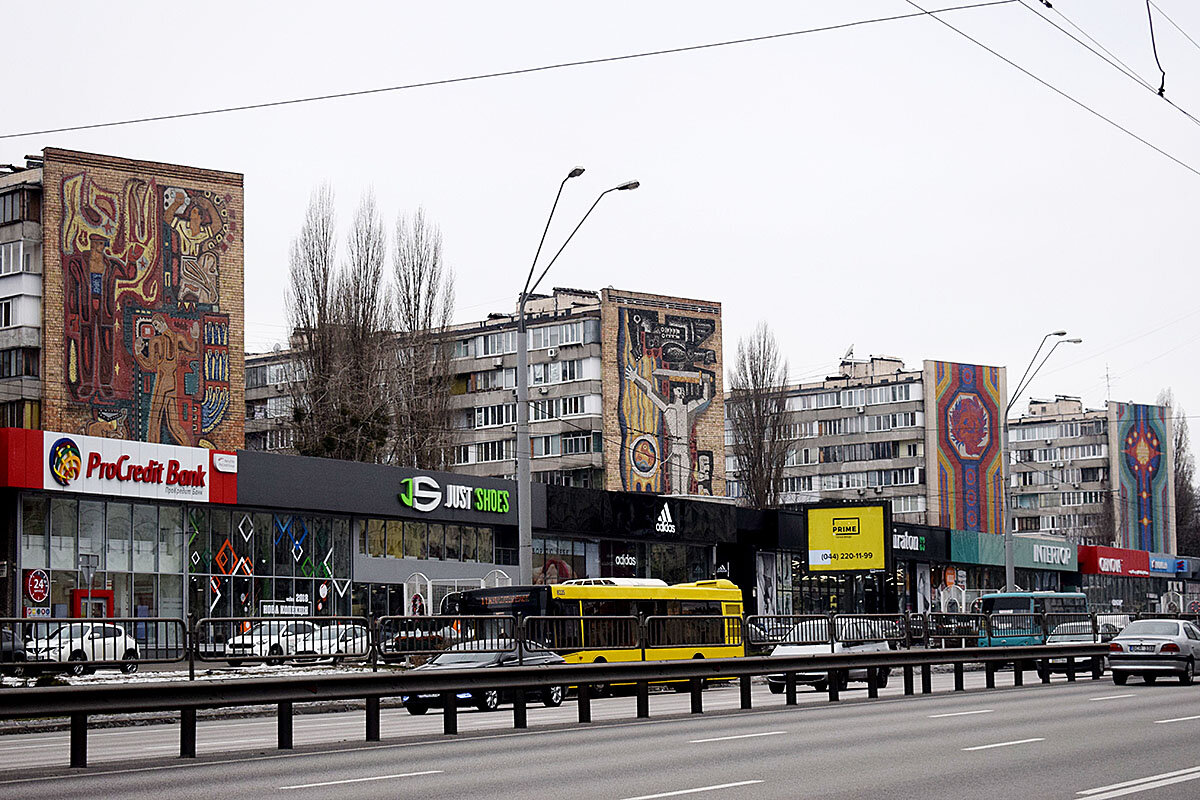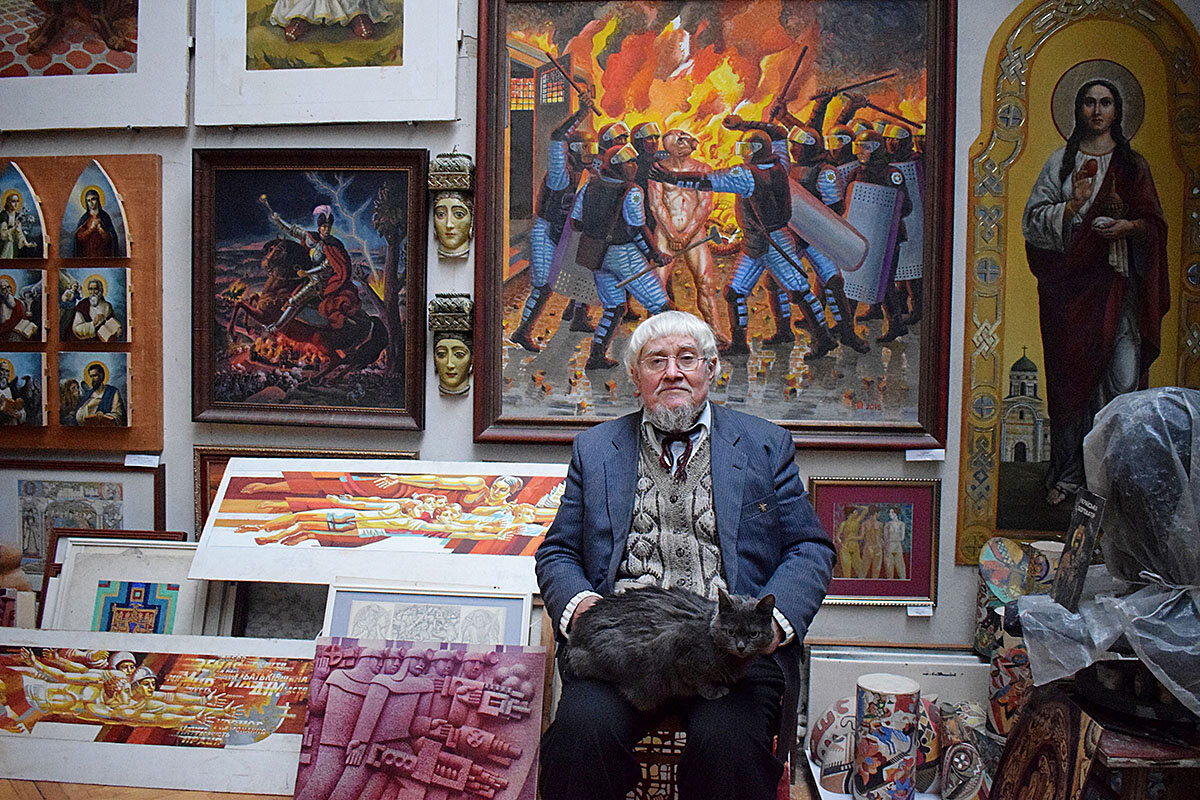In a bid to save Soviet-era art, Kiev activists preserve a slice of history
| Kiev, Ukraine
On a busy boulevard in central Kiev, five apartment buildings stand out from the surrounding concrete shops and buildings. Towering over Peremohy Avenue, the apartments feature brightly colored Soviet-era mosaics representing the phases of Ukraine’s history.
One showcases a medieval motif, while others glorify workers, soldiers, and science. And on another, against the background of a traditional Ukrainian design, is a hammer and sickle, the symbol of communism.
Mosaics like the ones on Peremohy Avenue are scattered throughout Ukraine, from universities to apartment buildings and rural bus stops. Since 2015 however, they have been under dual threat, first from decommunization laws aimed at removing symbols of the Soviet Union, and now from neglect, as the country attempts to modernize its aging cities.
Why We Wrote This
Eager to erase its communist past, Ukraine recently launched a campaign to destroy Soviet-era symbols. But efforts to preserve these works point to the value of art as an important relic of history.
But now, some Ukrainians have begun campaigning to preserve these unique works, seeing them as important, if complicated, relics of the nation’s history.
Ievgeniia Moliar, an art historian and activist based in Kiev has been involved in efforts to preserve mosaics around the city. “It was, of course, part of Communist propaganda by the government,” says Ms. Moliar of the mosaics. But at that time, she says, the artists who created them were often given more freedom than those in other disciplines and so developed “a lot of different languages to express ideas.” The results were sometimes masterpieces.
In 2015 however, many mosaics were scheduled for destruction after Ukraine’s parliament passed a series of laws which banned public symbols of the Soviet Union, ranging from statues of Soviet Union leader Vladimir Lenin to imagery like the hammer and sickle.
The laws were intended to eliminate visual reminders of the Soviet regime following the 2014 Ukrainian revolution, while allowing for the preservation of works with artistic value. But there is no agreement about which pieces from the Soviet period constitute art and no official registry of such works, so decisions about what should be preserved or destroyed could be arbitrary.
Izolyatsia, a non-profit arts organization, had begun a project to photograph and catalogue the works, but soon were responding to calls from people living near the mosaics to help save them.
When it was notified of plans to demolish the Peremohy apartment building mosaics, Izolyatsia launched a campaign to protect them, involving journalists and local residents, writing letters to officials, and purchasing informational plaques to mount near the mosaics. City authorities ultimately allowed the mosaics to remain.
‘You can't erase history’
Volodymyr Priadka is one of the artists who created the mosaics on Peremohy Avenue. Over two decades, he and his colleagues produced the intricate designs in a painstaking process using thousands of pieces of colored glass.
Most of Mr. Priadka’s work is now focused on religious and Ukrainian national themes – far more popular in today’s political environment. But while his themes have changed, he is adamant that public art from the previous era must be preserved. “You can’t erase history,” says Priadka. “Even if you don’t like it, and even if it was bad. It is our history.”
Since the initial decommunization push in 2015, much of the most obvious communist symbolism has been eliminated from Ukraine’s landscape. But for the remaining mosaics, the main threat is neglect.
Oleksandra Gaidai, a senior research fellow at the Museum of the History of Kiev, says many Ukrainians are simply unsure about which pieces from the Soviet period should be considered art. As such, preservation is not prioritized in local budgets, and many mosaics are allowed to decay until they must be removed.
Community-led preservation
Natalia Frolova is an engineer and mother of two who lives near Children’s Clinic No. 3, a pediatric medical clinic in Kiev’s Solomyansky district. On one of the clinic’s walls is a mosaic depicting a woman and three children wearing traditional Ukrainian clothing.
Ms. Frolova had been taking her children to the clinic and adjacent swimming pool for years when in 2017, she noticed workers preparing to remove the mosaic. The building owners had decided to destroy it – not because of decommunization, but in order to install additional insulation.
Frolova says the mosaic always lifted her mood, and she was disturbed to see it being torn down, so she posted a message about it in a neighborhood Facebook group and tagged a local preservation activist.
Over the following weeks, they contacted their member of parliament and journalists, and organized a press conference. With public concern building, the clinic owners eventually decided to leave the mosaic in place.
Frolova says she feels a sense of pride about what she was able to accomplish with her community. Still, she worries about whether this and other mosaics can be preserved from decay and future renovation efforts. “We need a balance between new and old,” she says.
Ms. Gaidai says she would like to see more community-led discussions like this when it comes to decisions about what Soviet-era art should be preserved.
“People are not feeling that the spaces in the city, in the villages, are their spaces,” she says.
And several art historians said public art should include informational plaques to offer context explaining its historic origins and meaning, as the art often comes from a complicated and sometimes dark period of Ukraine’s history.
But the notion that “the government decided it should be removed and so it was removed,” shouldn’t exist, adds Gaidai. To her, that practice itself seems like a Soviet relic.








